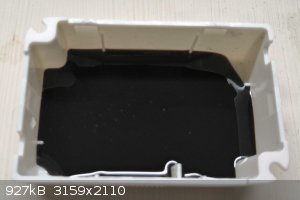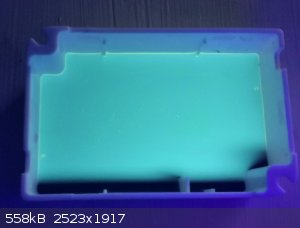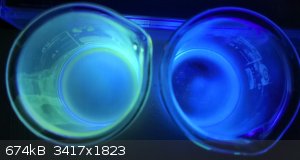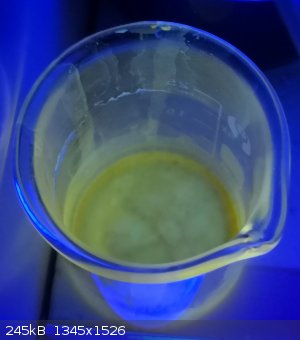valeg96
Hazard to Others
  
Posts: 253
Registered: 6-4-2014
Location: Italy
Member Is Offline
Mood: Moodless
|
|
Old bath oil is... fluorescent!
Hello everyone! Just a quick photos of something unexpected: I was gifted a brand new bottle of mineral oil for heating baths, Merck, ca.
late 1970s. Up until a few months ago it was still sealed and transparent, but it now turned to a black viscous mass, smelling of heavy diesel/tar,
probably rich in PAH and... fluorescent!
Attached are some photos of this now useless thing: it's a shame I can't even pull something useful out of it. It will also be tedious to dispose
of... unless someone with a private tugboat wants a liter of reagent-grade fuel? 
The fluorescence is best seen under UVA-BLB 370 nm tubes. Other common tubes (UVA 352 nm and UVC 325.7 nm) reveal nothing.
Edit: As I expected, it won't burn on a simple alcohol lamp, but heating lowers its viscosity and heavy fumes rise, smelling of construction bitumen.
Still, I'l keep a sample and dispose of the rest.
 
[Edited on 20-4-2020 by valeg96]
[Edited on 20-4-2020 by valeg96]
|
|
|
fusso
International Hazard
    
Posts: 1922
Registered: 23-6-2017
Location: 4 ∥ universes ahead of you
Member Is Offline
|
|
No!!! Keep that fluorescent oil! You can extract the fluorescent compounds out!
|
|
|
valeg96
Hazard to Others
  
Posts: 253
Registered: 6-4-2014
Location: Italy
Member Is Offline
Mood: Moodless
|
|
Well, I've thought about it already, and I wouldn't want to waste a shitload of solvents on that. Acetone kinda does the job, but again, there's no
way to identify or purify them... Isn't it?
|
|
|
fusso
International Hazard
    
Posts: 1922
Registered: 23-6-2017
Location: 4 ∥ universes ahead of you
Member Is Offline
|
|
My guess is 75% iPrOH. Try it on a small scale to see if the extract fluoresce.
[Edited on 200420 by fusso]
|
|
|
valeg96
Hazard to Others
  
Posts: 253
Registered: 6-4-2014
Location: Italy
Member Is Offline
Mood: Moodless
|
|
Left: Acetone. Right: iPrOH. Acetone is cheaper for me. I could extract them, distill the acetone, and repeat, assuming they won't break down on mild
heating. Needless to say, petroleum ether just waters it down.
A couple drops of acetone ended up on my bench. The fluorescence is extremely intense, and yellow/green.

[Edited on 20-4-2020 by valeg96]
[Edited on 20-4-2020 by valeg96]
|
|
|
fusso
International Hazard
    
Posts: 1922
Registered: 23-6-2017
Location: 4 ∥ universes ahead of you
Member Is Offline
|
|
Whats the colour of the solutions? Are they dark like the original?
|
|
|
valeg96
Hazard to Others
  
Posts: 253
Registered: 6-4-2014
Location: Italy
Member Is Offline
Mood: Moodless
|
|
No, they are yellow. The thick oil is so packed with fluorescent molecules I fear it will be a really long project, should I embark in it. Also,
heating the acetone solution over a flame does not destroy the fluorescent molecules.
Acetone is also much more efficient than iPrOH, at a glance.
Edit: The 5 mL of acetone I've used to very briefly treat the disrty plastic dish have already extracted enough fluorescent material to give a solid
residue. Given the colossal amount in this liter of stuff, I'll definitely try it.
[Edited on 20-4-2020 by valeg96]
[Edited on 20-4-2020 by valeg96]
|
|
|
mayko
International Hazard
    
Posts: 1218
Registered: 17-1-2013
Location: Carrboro, NC
Member Is Offline
Mood: anomalous (Euclid class)
|
|
Neat! Do you have any chromatography supplies? Even a quick & dirty on a coffee filter might be interesting
al-khemie is not a terrorist organization
"Chemicals, chemicals... I need chemicals!" - George Hayduke
"Wubbalubba dub-dub!" - Rick Sanchez
|
|
|
valeg96
Hazard to Others
  
Posts: 253
Registered: 6-4-2014
Location: Italy
Member Is Offline
Mood: Moodless
|
|
I have two packets of plastic TLC sheets 60 F254 (Merck 1.05750) but they are poorly revealed by my 4W tube (my other lamp is being repaired). I'll
see what I can do.
The evaporated 5 mL left a yellowish residue, coated in oily traces, and further purification may be possible. It's fluorescent (yellow), but not as
much as the solution.

|
|
|
nezza
Hazard to Others
  
Posts: 324
Registered: 17-4-2011
Location: UK
Member Is Offline
Mood: phosphorescent
|
|
Most greases and oils are fluorescent. It's interesting to scan your oven and the area around it with a UV source to see just how much you miss when
cleaning it.
If you're not part of the solution, you're part of the precipitate.
|
|
|
G-Coupled
Hazard to Others
  
Posts: 287
Registered: 9-3-2017
Member Is Offline
Mood: Slightly triturated
|
|
Why would the mineral oil have turned suddenly after all these years in a sealed bottle, do you think?
|
|
|
valeg96
Hazard to Others
  
Posts: 253
Registered: 6-4-2014
Location: Italy
Member Is Offline
Mood: Moodless
|
|
I've attempted an extraction, but as I feared, it's an impossible feat. The extraction works way too well: once you shake it enough, the acetone
extracts a lot of tarry brown residues as well, so I'd end up with a brown tarry, sticky mass and little to no hope of further purifications. As said,
I'll just keep a sample and dispose of the rest.
Quote: Originally posted by nezza  | | Most greases and oils are fluorescent. It's interesting to scan your oven and the area around it with a UV source to see just how much you miss when
cleaning it. |
Indeed. I've spilled a couple drops of the acetone extract and now my temporary bench is permanently fluorescent like a crime scene.
|
|
|
unionised
International Hazard
    
Posts: 5102
Registered: 1-11-2003
Location: UK
Member Is Offline
Mood: No Mood
|
|
Something that is brightly fluorescent probably doesn't contain much fluorescent material.
[Edited on 30-4-20 by unionised]
|
|
|
valeg96
Hazard to Others
  
Posts: 253
Registered: 6-4-2014
Location: Italy
Member Is Offline
Mood: Moodless
|
|
I agree with that, but given the large amount of material and the bright fluorescence of the residue, I hoped I'd get out something. Unfortunately, as
stated, way too much sludge dissolves in the acetone.
|
|
|
fusso
International Hazard
    
Posts: 1922
Registered: 23-6-2017
Location: 4 ∥ universes ahead of you
Member Is Offline
|
|
I think IPA is more polar than acetone so less hydrocarbons will dissolve into it.
|
|
|
nezza
Hazard to Others
  
Posts: 324
Registered: 17-4-2011
Location: UK
Member Is Offline
Mood: phosphorescent
|
|
G-Coupled. I suspect the oils become fluorescent as a reult of partial oxidation.
If you're not part of the solution, you're part of the precipitate.
|
|
|
G-Coupled
Hazard to Others
  
Posts: 287
Registered: 9-3-2017
Member Is Offline
Mood: Slightly triturated
|
|
Interesting, cheers. What manner of compounds would be formed thusly, I wonder? And why seemingly all of a sudden?
[Edited on 4-5-2020 by G-Coupled]
|
|
|